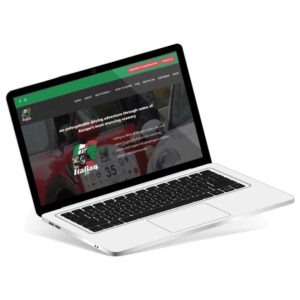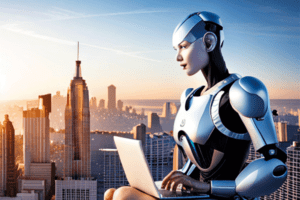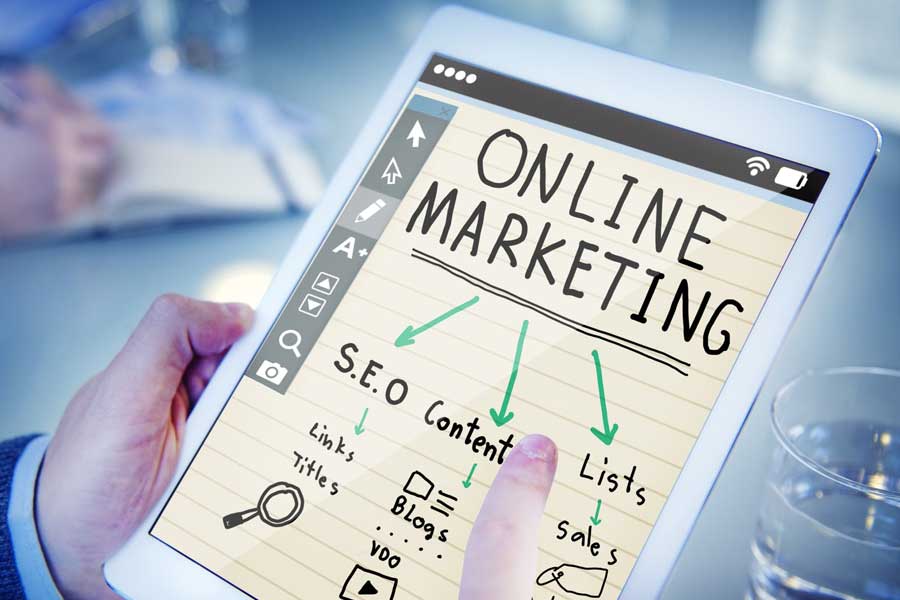In today's digitally-driven world, franchisors face the challenge of ensuring that their franchisees have a…
10 Digital Trends for 2024

The growth in technology is not slowing with time, technology is becoming an ever more integral part of our lives. From social media to e-commerce and beyond, websites and digital platforms are now a key part of how businesses operate. It’s important to stay ahead of the curve when it comes to trends in website design and digital marketing – so what do we expect from 2024? In this blog post, we look at some emerging trends that we think will shape the future of web development throughout 2024 and beyond.
Immersive 3D Elements
Expect an increased use of immersive 3D elements, from graphics to interactive experiences, creating a more engaging and dynamic online environment. These types of features use computer graphics to create a three-dimensional environment within which users can interact with objects or characters in real-time.
This technology has been used for years in video games but is now becoming more widely available for websites as well. Examples include virtual reality tours, interactive product demonstrations, 360-degree videos/photos, augmented reality apps and much more!
Dark Mode Design
 Dark mode design, known for reducing eye strain and conserving device battery, will continue to gain popularity, providing users with a sleek and modern interface option. The popularity of dark mode designs will continue to grow over the next few years, with many web designers beginning to incorporate them into their projects. By 2024, we predict that most major websites will have some form of dark mode enabled on their sites to provide an optimal user experience for visitors who prefer this style over traditional white backgrounds with black text.
Dark mode design, known for reducing eye strain and conserving device battery, will continue to gain popularity, providing users with a sleek and modern interface option. The popularity of dark mode designs will continue to grow over the next few years, with many web designers beginning to incorporate them into their projects. By 2024, we predict that most major websites will have some form of dark mode enabled on their sites to provide an optimal user experience for visitors who prefer this style over traditional white backgrounds with black text.
Dark modes offer several advantages compared to standard website design: they are easier on the eyes during night-time browsing; they reduce glare from bright displays; they use less power (which is great news if you’re using battery-powered devices); and lastly, darker colours tend to be more calming which can help improve focus while working online or surfing the internet late at night. In addition, some studies suggest that people find darker colour schemes easier on their eyes than lighter ones – so it makes sense why this trend has been gaining traction lately!
Minimalistic Micro-interactions
Minimalist micro-interactions are small UI animations or effects that help create a more interactive experience for users. They’re designed to be subtle yet effective at providing feedback when certain actions take place, such as clicking on a button or scrolling down the page. Examples include hover states which change colour when you move your mouse over them; loading bars that appear while content is being loaded; and fading transitions between pages or sections of content within one-page layout. All these elements contribute to creating an enjoyable user experience by giving visual cues about what’s happening behind the scenes – something which traditional static web designs lack completely!
Augmented Reality (AR) Integration
 AR features will likely become more prevalent, enhancing user interactions by overlaying digital elements onto the real world through the user’s device camera. AR integration will be key for providing interactive experiences that are engaging and immersive. For example, customers could virtually try on clothes before they buy them or virtually explore a room before purchasing furniture online – all without leaving their homes!
AR features will likely become more prevalent, enhancing user interactions by overlaying digital elements onto the real world through the user’s device camera. AR integration will be key for providing interactive experiences that are engaging and immersive. For example, customers could virtually try on clothes before they buy them or virtually explore a room before purchasing furniture online – all without leaving their homes!
Businesses can also leverage this technology to create more personalised experiences tailored specifically for each user’s needs based on their preferences or past interactions with the company’s website/applications/products etc, leading to higher customer satisfaction levels overall as well as increased sales opportunities over time due to better targeting tactics employed by businesses using AR integration into their sites/apps etc.
Variable Fonts
Variable fonts allow for more flexibility in design by offering various styles and weights within a single font file, enabling greater creativity and customisation in typography. Variable fonts are a relatively new technology that has the potential to revolutionise website design.
A variable font is a single file which contains multiple styles of typefaces, allowing designers to switch between different looks quickly and easily without having to download or install additional fonts. This makes it much easier for web developers and designers to create unique designs with more flexibility than ever before.
The biggest benefit of using variable fonts is that they reduce page load times significantly, as only one file needs to be downloaded instead of several separate files for each style used in the design. This means less time waiting for pages on websites, resulting in improved user experience overall. Additionally, because all styles are contained within one file size remains small despite having multiple variations available at once – another great advantage when creating responsive designs across various devices and platforms.
Voice User Interface (VUI)
 Voice user interfaces (VUIs) are a type of technology that allows users to interact with computers and other devices using voice commands. VUIs have already become commonplace in many consumer products, such as smartphones and home assistants like Amazon’s Alexa, Google Home, and Apple’s Siri. As this technology continues to grow in popularity over the next few years it will have an ever-increasing impact on website design for 2024.
Voice user interfaces (VUIs) are a type of technology that allows users to interact with computers and other devices using voice commands. VUIs have already become commonplace in many consumer products, such as smartphones and home assistants like Amazon’s Alexa, Google Home, and Apple’s Siri. As this technology continues to grow in popularity over the next few years it will have an ever-increasing impact on website design for 2024.
One way VUI will affect website design is by creating new opportunities for user engagement through interactive elements like chatbots or voice search functions. This could allow websites to provide more personalised experiences tailored specifically towards each individual visitor based on their past interactions with the site or preferences they may share when prompted by a chatbot or voice command feature. Additionally, these features can provide visitors with faster access to information since they don’t need to take time searching through menus or typing out queries into search bars – instead, they can simply ask what they’re looking for aloud.
Sustainability and Eco-Friendly Design
Sustainability and eco-friendly design are two concepts that have become increasingly important in the world of web design. As businesses strive to be more environmentally conscious, they must also consider how their websites can help them reach this goal. For a website to truly be sustainable and eco-friendly, it must incorporate certain elements such as energy efficiency, renewable resources, waste reduction strategies and green technologies.
In terms of energy efficiency, web designers should focus on reducing the amount of electricity used by servers or other hardware associated with hosting a website. This could include switching from traditional hosting services to cloud computing solutions which use less power overall but still provide reliable performance levels for users accessing your site online. Additionally using efficient coding practices when building out pages will ensure that visitors don’t experience slow load times due to inefficient code running in the background behind each page view request made by someone visiting your site online.
Advanced CRM integration and adoption
As technology continues to evolve, businesses are looking for ways to stay ahead of the competition. Advanced CRM integration and adoption is one way that organisations can keep up with the ever-changing landscape.
CRM stands for Customer Relationship Management and refers to a system used by companies to manage customer data such as contact information, purchase history, preferences etc., to provide better customer service. Advanced CRM integrates multiple software systems into one unified platform which allows businesses greater access and control over their customers’ data across various channels (e-commerce sites social media platforms etc). This type of integrated approach enables companies not only to track their customers’ behaviour but also to gain insights into who they should be targeting with marketing campaigns or other initiatives based on these behaviours.
 Advanced CRMs also allow organisations more flexibility when it comes time to make changes or updates since all relevant information is stored within a single platform rather than spread out over multiple programs/systems. As such, adopting an advanced CRM helps streamline operations while providing valuable insights that can inform decisions moving forward.
Advanced CRMs also allow organisations more flexibility when it comes time to make changes or updates since all relevant information is stored within a single platform rather than spread out over multiple programs/systems. As such, adopting an advanced CRM helps streamline operations while providing valuable insights that can inform decisions moving forward.
So how might this impact website design come 2024? Well, thanks to its ability to store vast amounts of user-related data, an advanced CRM could enable web designers to create personalised experiences tailored to each visitor based on past interactions/purchases made through the site – essentially creating “smart websites” capable of adapting quickly changing needs wants consumers have throughout the buying journey. Additionally leveraging AI machine learning capabilities found within many modern CRMs would open doors completely new level of customisation never seen before allowing brands to truly stand apart from competitors both terms of functionality overall look feel provided to visitors upon arriving at the page. All said and done, having CRM implemented correctly could mean far deeper engagement levels of visitors leading to higher conversion rates and increased sales revenue bottom line.
Advanced CRM Integration Adoption will play a key role in impacting future website designs come 2024 offering business owners much-needed tools to help them stay competitive in the marketplace while giving users a unique personalise experience every visit.
AI-Driven Personalisation
AI-driven personalisation is a technology that uses artificial intelligence (AI) to customise website experiences for individual users. AI-driven personalisation allows websites to analyse user behaviour and make decisions about what content, products, or services should be presented to best meet the needs of each visitor. In other words, it enables websites to provide personalised experiences tailored specifically for each individual based on their interests and preferences.
In 2024, AI-driven personalisation will have an even bigger impact on website design than it does today. As more businesses recognise the value of customising web experiences for their visitors, they’ll invest heavily in developing advanced AI technologies that can accurately predict user behaviour and deliver highly targeted content accordingly. This will lead to improved customer satisfaction as well as increased sales conversions due to better engagement with customers who are more likely interested in what’s being offered by the business online.
Immersive User Experiences with Extended Reality (XR)
The world of technology is constantly evolving, and one of the most exciting developments in recent years has been the emergence of Extended Reality (XR). XR combines virtual reality (VR), augmented reality (AR), and mixed reality (MR) to create a more immersive user experience. In 2024, XR will become an integral part of website design as it allows users to interact with content in new ways that were not possible before.
 In terms of website design itself – expect lots of changes over the next few years due to increased demand from consumers wanting amazing-looking sites packed full of features powered by this new technology. Think realistic textures & lighting effects combined with motion tracking capability allow viewers to explore product pages 360 degrees without leaving the comfort of their own home, all while being able to track customer behaviour patterns better than ever, thus giving businesses valuable insights to improve overall UX further down the line. With these advances come challenges though such as ensuring compatibility across multiple platforms to ensure a smooth transition between different types of hardware/software configurations, luckily developers are already working hard to bring the best solutions to market soon enough time comes around 2024 when we’ll truly appreciate power extended realities offer us our everyday lives.
In terms of website design itself – expect lots of changes over the next few years due to increased demand from consumers wanting amazing-looking sites packed full of features powered by this new technology. Think realistic textures & lighting effects combined with motion tracking capability allow viewers to explore product pages 360 degrees without leaving the comfort of their own home, all while being able to track customer behaviour patterns better than ever, thus giving businesses valuable insights to improve overall UX further down the line. With these advances come challenges though such as ensuring compatibility across multiple platforms to ensure a smooth transition between different types of hardware/software configurations, luckily developers are already working hard to bring the best solutions to market soon enough time comes around 2024 when we’ll truly appreciate power extended realities offer us our everyday lives.
As technology continues to evolve, businesses need to stay ahead of the curve when it comes to trends in website design and digital marketing. There’s no doubt that 2024 will be another exciting year full of innovation within website design & digital marketing – so make sure you keep up with all these upcoming changes if you want your business to succeed online during this period.
If you would like to chat with us about any of these digital trends for 2024, please contact us or call 0203-920 7276. We are experts in all digital technologies and are always excited to speak with businesses that are looking to utilise the latest technology to drive success online.



